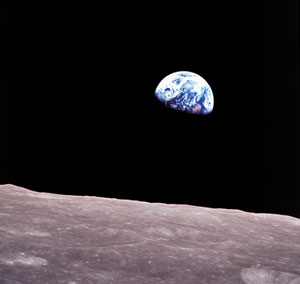
This Article From Issue
July-August 2001
Volume 89, Number 4
DOI: 10.1511/2001.28.0
People have understood why the nominally dark side of the Moon glows dimly ever since Leonardo da Vinci first discerned the cause: illumination by earthlight. In the 1920s, French astronomers exploited this phenomenon to measure the fraction of sunlight hitting our planet that is reflected back into space, an important physical quantity known as the Earth's albedo. Now a team of astronomers working at the Big Bear Solar Observatory in California has revived and modernized this technique in an effort to track long-term changes in planetary reflectivity, which could be an important influence on global climate. Their first publication on the subject appeared in the May 1 issue of Geophysical Research Letters.

NASA
The general prescription for measuring albedo in this way is simple: Pick two places on opposite sides of the near hemisphere of the Moon, one located close to the eastern edge of the lunar disk, one close to the western edge. Then when the Moon is partially full, one of these locales will be awash in sunlight, and the other bathed only weakly by earthlight. Comparing the brightness of the two spots (and taking into account such things as the intrinsic difference in reflectivity between the two chosen lunar sites and the area of the Earth reflecting light toward the Moon) gives a convenient measure of albedo.
Although orbiting satellites can also be employed to gauge the Earth's reflectivity, their use is problematic for several reasons. Typical satellite views are expansive but not global, so they only provide albedo measurements for the swath of the Earth over which they pass. Also, the optical sensors carried into space tend to degrade with time, and thus it is difficult to maintain an accurate calibration over the long term. And, as Philip Goode (the lead investigator on the new work) noted to NASA when he proposed to perform albedo measurements from the ground, "the enterprise is far, far cheaper!"
It is inexpensive, of course, because nothing other than the Moon needs to be hurtling through space. Indeed, the hardware requirements for an observation are quite simple. The Big Bear investigators used a telescope of only modest size—a 6-inch refractor. They imaged the Moon with an electronic sensor (a standard charged-coupled device) by alternately inserting and removing a filter that diminished the amount of light by a factor of about 100,000. This maneuver allowed them to obtain images that appeared similarly bright for both the sunlit and earthlit portions of the Moon. They then measured the intensity of light from the two chosen spots for a total of 270 nights (72 in 1994 and '95; 198 between 1998 and 2000).
These albedo measurements showed the expected seasonal variations, with cloudy skies producing high values of albedo. But they also revealed a longer-term change of about 2.5 percent over half a decade. During the earlier measurement campaign, the Sun was at a minimum in its 11-year cycle of activity, whereas the more recent measurements were taken as the Sun approached a maximum. The investigators were quick to point out that their findings, with the Earth reflecting more sunlight during a solar minimum and less during a solar maximum, support a theory put forth in 1997 by Henrik Svensmark and Eigil Friis-Christensen of the Danish Space Research Institute, who linked cloudiness with solar activity.
Their theory invokes a series of plausible if not completely confirmed physical connections. Solar activity modulates the flux of galactic cosmic rays impinging on the Earth (a well-known phenomenon), and these cosmic rays create ions in the atmosphere, which in turn provide condensation centers for cloud droplets to form. So according to the Danish hypothesis, one would expect periods of minimal solar activity (maximal cosmic-ray flux and ions) to coincide with enhanced global cloudiness. This is just what the new albedo measurements show.
There are, however, reasons to think that the correspondence may have come about for different reasons. One complication is that cosmic rays should, in principle, produce their greatest effects at high latitudes, where shielding of these charged particles by the Earth's magnetic field is weakest. Yet the measurements of albedo from earthlight for the most part sense the reflectivity of low-latitude zones, a consequence of the viewing geometry, because the Moon is situated roughly in the Earth's equatorial plane.
Perhaps, as Goode and his colleagues point out—and as Paul Farrar, a physical oceanographer at the Naval Oceanographic Office in Bay St. Louis, Mississippi, has before argued—large differences in equatorial cloudiness may simply be the result of changes in El Niño conditions over the Pacific. The first round of albedo measurements were taken during a protracted El Niño, whereas the latter set were obtained while more typical oceanographic conditions prevailed. Further observations from the Big Bear Observatory over the next solar cycle should help discern whether the sea or the Sun really drives changes in cloudiness. But whatever the root cause, it is impressive to think that such climatological shifts are reflected, quite literally, in the face of the Moon.—David Schneider
American Scientist Comments and Discussion
To discuss our articles or comment on them, please share them and tag American Scientist on social media platforms. Here are links to our profiles on Twitter, Facebook, and LinkedIn.
If we re-share your post, we will moderate comments/discussion following our comments policy.